
The South American state of Uruguay boasts pretty Atlantic beaches, gaucho festivals, parks and botanical gardens, and magnificent colonial architecture from ancient cities. Going on a trip, take with you a Russian-Spanish phrasebook, because the official language of Uruguay is Spanish.
Some statistics and facts
- Uruguay has a population of 2.2 million and the vast majority of its inhabitants speak Spanish.
- On the border of the northern part of the country with Brazil, the portugnol dialect is widespread - a mixture of Portuguese and Spanish, allowing people speaking these languages to understand each other.
- Before the colonization of Uruguay in the 16th century, tribes of the Charrua Indians lived on its territory. Unfortunately, they have not survived as a separate people and only their mestizo descendants live in the country. The language of the Charrua Indians was also lost.
Portugnol or frontier
Of undoubted interest for language researchers is the portugnol dialect, invented by the inhabitants of the border areas of Uruguay and Brazil. The official language of Uruguay is Spanish, and Brazil is Portuguese, and therefore the people living in the neighborhood needed a lingua franca with which they could fully communicate.
As closely related Romance languages, Portuguese and Spanish have similar grammatical structures and similar vocabulary. Long-term contact between two neighboring languages led to the emergence of the Portuñol dialect. The found "common language" in every sense helped the neighbors to conduct successful trade and successfully cooperate in many other areas.
By the way, portunol also exists in the Old World. On the border between Portugal and Spain, Europeans also use a combined language for communication. This dialect has appeared in recent years not only in ordinary speech, but also in other areas. Some literary works have even been written on portugnol.
Tourist notes
To travel around Uruguay, it is desirable to know the state language of the country, but not necessary. It is enough to use the services of English-speaking local guides to help you avoid the difficulties of translation. Information in English is available in the capital in important tourist areas, but this is more the exception than the rule.
In order to feel comfortable, it is better to memorize a few welcome phrases in Spanish and have an idea of things that are important to the traveler, for example, the names of the main dishes on the menu of restaurants.






